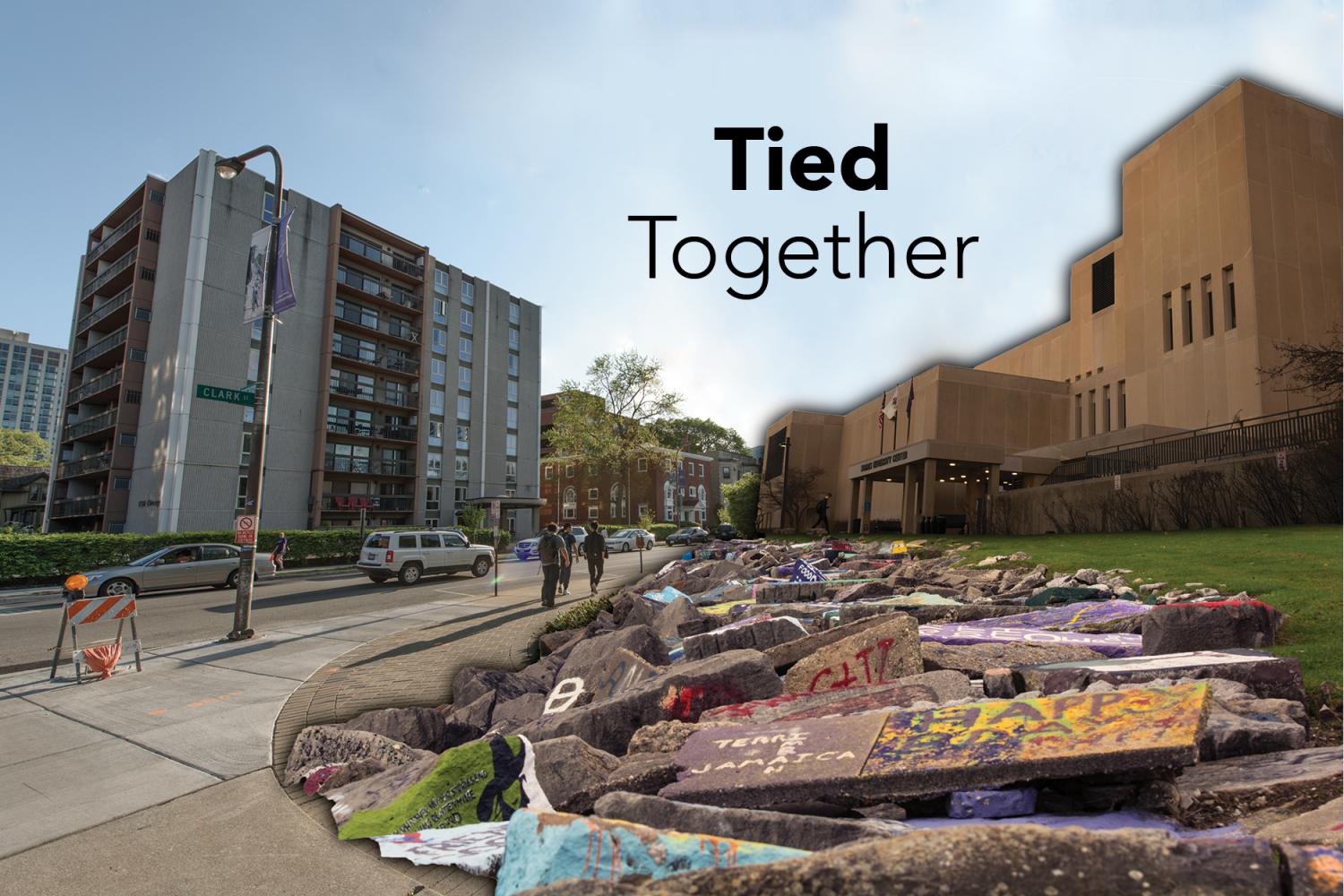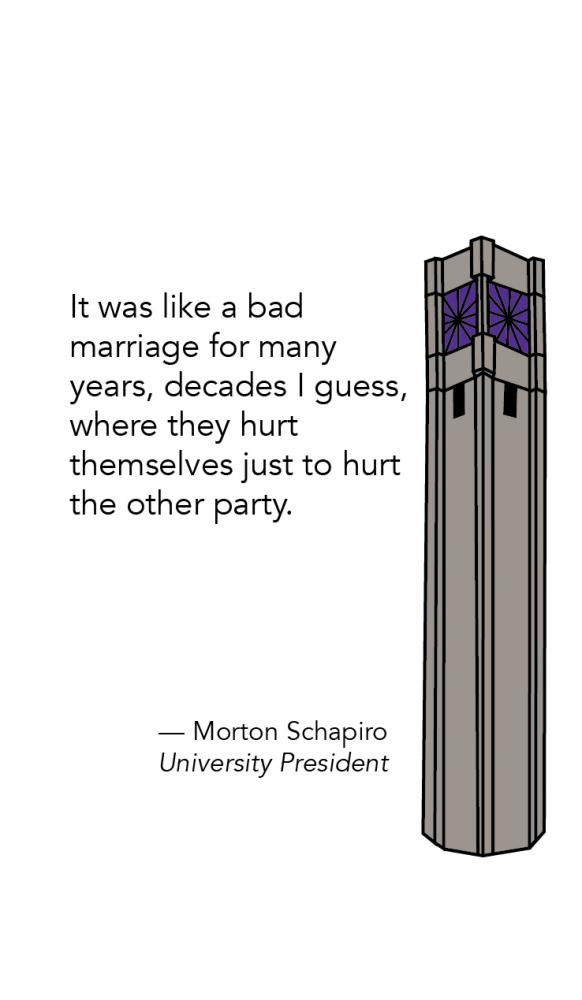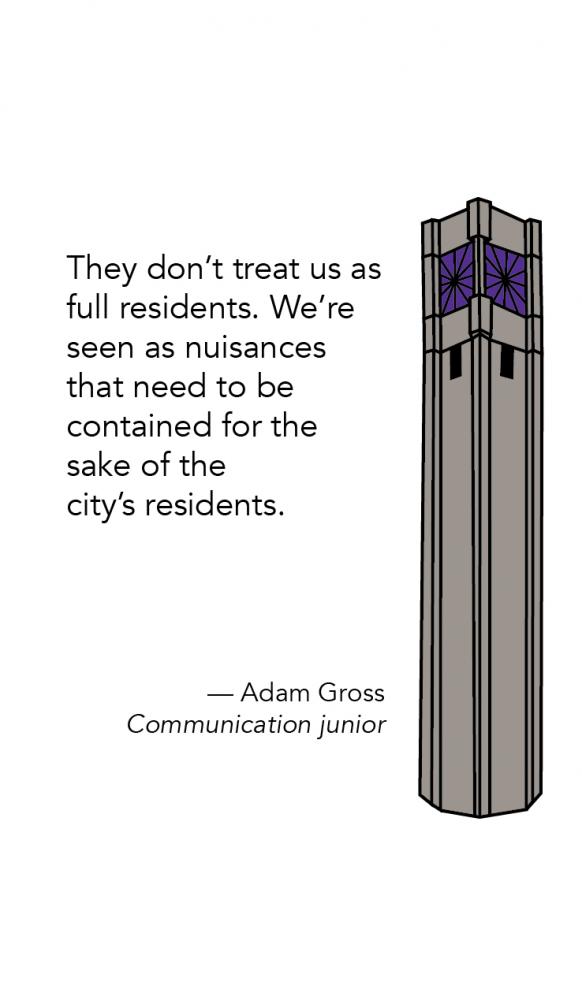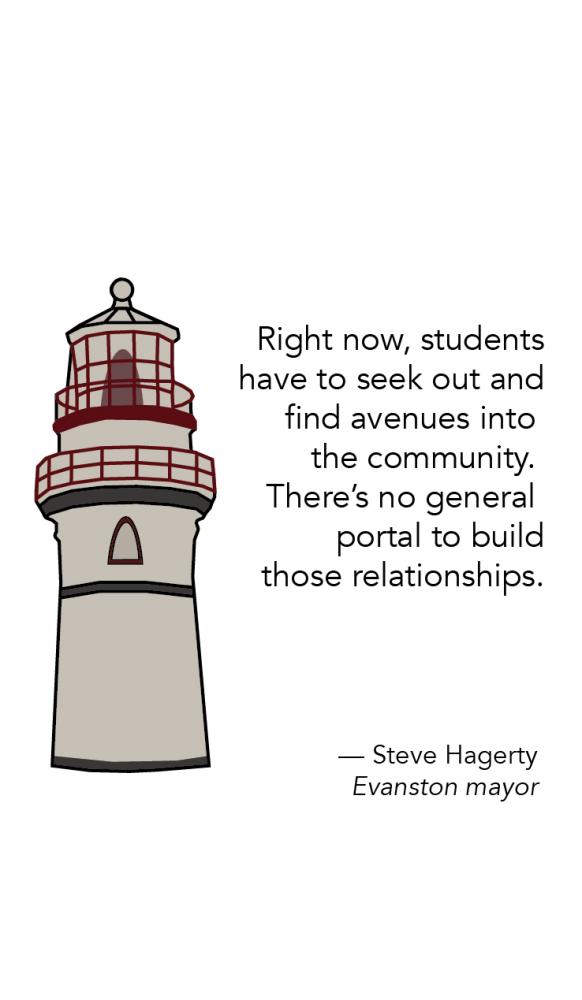In Focus: As town-gown strains subside, concerns over communication gaps, University contributions linger
May 19, 2017
When Morton Schapiro stepped into his role as Northwestern’s president in 2009, Elizabeth Tisdahl, who had just been elected Evanston mayor, immediately reached out to him.
Tisdahl said she threw Schapiro a welcoming party and gave him homemade baked goods to send a clear message: She wanted the town-gown feud to be over.
Relations between the city and the University had long been strained due to persisting student-resident conflicts and property tax concerns, coupled with brief land ownership battles in the 1960s and lawsuits filed in the late 1990s.
Though some of the conflict was not unusual to most town-gown relationships, officials said few community discussions were led to mitigate the tension before Schapiro and Tisdahl entered office.
“It was like a bad marriage for many years, decades I guess, where they hurt themselves just to hurt the other party,” Schapiro told The Daily in March.
Over the last eight years, Schapiro said he and Tisdahl developed a great friendship, in addition to their working relationship.
Town-gown relations improved under their leadership, said Alan Anderson, NU’s executive director of neighborhood and community relations. He said NU increased its financial contributions to, and sustainable partnerships with, the city, which weren’t as visible prior to Schapiro’s tenure.
But even as the ties grow among top-level officials and begin to extend into the broader community, communication gaps remain.
There are few direct avenues for residents to contact the University and even fewer for students to contact the city’s government. Residents continue to worry about NU acquiring properties — therefore taking them off the tax roll — and some say the University’s initiatives in Evanston haven’t reached enough community members.
With a new mayor elected this year and Northwestern hoping to maintain the relationship’s positive trajectory, several residents, students and officials said there is more to be done.
“I want Evanston to feel like they own the University, and the University to feel like they own Evanston,” Anderson said.
Paying a fair share
Many concerns in the years before Tisdahl and Schapiro came into office ranged from issues with students living off campus to the impact of Northwestern events and construction.
As the two entities struggled to integrate their communities, Tisdahl said, city officials for a long time blamed NU “for all of its problems” based on one reason: The University does not have to pay property taxes.
Northwestern is exempt from these taxes due to its nonprofit status and a charter from the state of Illinois that predates Evanston’s establishment as a city.
“(Aldermen) would say, ‘If only NU paid property tax, we could fix this or that’,” Tisdahl said. “(That mindset) worked well for the city because we never had to solve any problems, and Northwestern never had to contribute to the city.”
There are still many community members who look for examples of stronger economic ties between the city and the University, Ald. Eleanor Revelle (7th) said.
Revelle said some residents’ fears worsen whenever NU acquires a new off-campus property that is then taken off the tax roll. Some residents worry their own property taxes may then increase, she said.
Under Schapiro and executive vice president Nim Chinniah, there has been greater transparency from the University whenever it plans to purchase another property, city manager Wally Bobkiewicz said.
And, for the three properties it purchased in the past three years — 1840 Oak Ave., 630 Clinton St. and 2522 Orrington Ave. — the University decided to annually reimburse slightly more than what it would have paid in taxes.
After the University sent a Jan. 31 letter to City Council members saying it would acquire the Oak Avenue property, Ald. Judy Fiske (1st) asked city staff to examine past agreements between the city and Northwestern to determine whether the building must remain on the city’s tax roll and if city officials had to approve the sale.
The property is located in “Research Park,” an area that hosts firms and startups created by Northwestern faculty. Under a 1988 agreement, no property in the area could be sold or leased to a tax-exempt entity without city approval, according to council documents. However, 1840 Oak Ave. was later exempted from this rule.
The University decided to make an annual, voluntary payment of $350,000 to the city to cover all three properties it acquired. The estimated 2016 tax amount was $317,253, according to council documents.
Bobkiewicz said the city hopes to work with University administrators to solidify a regular process for determining which properties will be funded.
Even though NU has decided to reimburse the last three properties it acquired, 3rd Ward resident Bob Norris said he is concerned there hasn’t been a commitment made for all future acquisitions.
Norris said he hopes if the value of the purchased buildings rises over time, the amount of money Northwestern pays for them will also increase so that tax dollars aren’t lost.
Anderson said the University reimbursed the tax on the three properties because the acquisitions occurred while Evanston/Skokie School District 65 was considering an increase in property taxes to stabilize its finances. Though the two issues weren’t related, Anderson said University administrators didn’t want to further impact the community.
Although the University made some financial contributions to the city before 2009, Anderson said there seems to have been an increase in spending under Schapiro.
Administrators said NU directly contributes to the city through millions of dollars in permits, taxes and fees. Northwestern is also the source of sales tax from athletic merchandise and money for shared health care services, school systems and nonprofits. Additionally, earlier this year, NU donated $1 million for the redevelopment of the Robert Crown Community Center.
Another major donation to the city is made through the Good Neighbor Fund, which was set up in March 2015 and gives the mayor $1 million annually for five years to fund programs and services agreed to by Schapiro.
Still, 3rd Ward resident Alex Block said many residents feel NU is not fulfilling its “responsibility” to help during a tight economic environment. While Northwestern has a $2.2 billion budget, the city’s adopted fiscal year 2017 budget is just over $311 million.
Several residents said they know the University contributes to the community in more collaborative ways than just the Good Neighbor Fund donation, but they do not know the full impact.
Block, who ran for 3rd Ward alderman, said to move forward, the University needs to put out a clear audit of all the ways it is contributing.
“We need to figure out what dollar figure that equates to,” Block said. “It’s really important because there are a lot of people in this community who are struggling, whether it’s feeling the burden of increased property taxes … that want to know everyone in the city is doing their fair share.”
Anderson said he is working on compiling a public document detailing the finances behind the University’s community involvement.
But the cash flow shouldn’t be the entire story, Anderson said, as Northwestern’s collaboration with schools, nonprofits and the community has grown since 2009.
“I always say jokingly that unless the University pours out the entire endowment over the city of Evanston, everyone will say the number is not enough,” he said.
From money to impact
Hundreds of partnerships were formed across various sectors of the city and university alike in an effort to shift the conversation from money to impact, Anderson said.
Historically, NU engagement was fragmented, as the administration, schools and departments all had their own initiatives.
Before Schapiro, officials and residents said, there was much less of a desire on the University’s part to engage with the community.
“You got the feeling that the former president, (Henry) Bienen, couldn’t care less about town and gown relationships,” said Peter Lobin, a 1st Ward resident.
Bienen, however, rejected this characterization. In an email to The Daily, Bienen said under his administration, Northwestern sold off property to help the city and put funds into the local school districts, safety programs and the parks.
“Of course I and others cared a great deal,” Bienen said in the email.
Over the past few years, as Anderson and other administrators have worked to provide a cohesive messaging frame for all of NU’s initiatives, a few partnerships directly impacting Northwestern and Evanston residents rose in prominence.
In fall 2012, for example, NU created a formal partnership office at Evanston Township High School, said Kristen Perkins, the NU-ETHS partnership coordinator.
Such partnerships, she said, increased contact between teachers and Northwestern professors, helped ETHS implement classes mirroring NU courses and invited guests who benefited both ETHS and NU students.
There has been an increase in ETHS students enrolling at Northwestern, Schapiro told The Daily in March. Until a few years ago, fewer than half a dozen ETHS students would come to the University, but the class of 2020 has about 20 students who get need-based aid and special scholarships for being local, he said.
Anderson said NU’s stronger and more visible presence at the high school invariably leads to more students and families considering staying local for college.
“People say, ‘Hey, wait. I never thought Northwestern might be an option for me. I never felt that the University was open or welcoming or available or that I can access it’,” Anderson said. “And now they are feeling that as more interactions happen.”
The University also opened a partnership office with District 65 last fall focused on science, technology, engineering and mathematics.
In addition to the roughly 2,400 Evanston residents already employed by NU, the city’s government partnered with Northwestern Facilities Management in fiscal year 2016 to roll out two labor and growth programs focused on intentional partnerships, Anderson said.
One assists small businesses, while the other trains six residents per year in a skilled trade, vice president of Facilities Management John D’Angelo said.
The trade pre-apprenticeships are paid, D’Angelo said, and those who “graduate” the program after one year are given jobs as full-time NU employees.
In an April interview with The Daily, Schapiro said he was walking down Sheridan Road a few days prior and bumped into an employee from Northwestern Facilities Management.
The employee introduced Schapiro to one of the young people training with NU and told the president that he would be “lucky to hire this kid,” Schapiro said.
“The whole rest of the way I smiled,” Schapiro said. “I was thinking, ‘This is a kid with tremendous talent being realized and developed through a relationship between the city and the University.’ You can always do more of that.”
Evanston resident Joshua Emanuel, one of this year’s cohort of six, said the opportunity opened his eyes to a side of Evanston he had never experienced in his 28 years living there.
“When I thought about Northwestern I thought about purple, the Rose Bowl team and a super, super smart university,” Emanuel said. “Since working with Northwestern, I found out there are so many caring individuals that work here.”
Lacking communication
Although perceptions of the University are changing, some residents still feel they’re left out during much of Northwestern’s planning process for initiatives and developmental projects.
Seventh Ward resident Laurie McFarlane said when NU began its redevelopment project for Ryan Field’s west parking lot last year, it informed all neighbors within 500 feet of the parcel about its plans.
“The project manager for the parking lot redevelopment initially was not very interested in the neighbors’ concerns,” McFarlane said. “(Developers) naturally focus on the things they care about.”
McFarlane said residents were worried because the initial proposal included plans for bright LED lights, an unwanted entrance from the neighborhood into the parking lot and landscaping that would insufficiently block light and noise.
Revelle, the 7th Ward alderman, said she facilitated meetings between neighbors and University staff to convey residents’ concerns. After discussions and an online petition, Revelle said administrators returned with ideas that benefited the community, including the installation of a fence to block out tailgaters from the neighborhood on game days.
The end result, McFarlane said, was a “huge wave of appreciation” for the University’s commitment.
Anderson said the University needs to overcome fractured communication to engage residents when it builds or redesigns a property. Administrators have found their communication with residents must be more personalized rather than just electronic, he said.
Residents said recent hires such as Anderson and D’Angelo have more assertive attitudes than their predecessors in expanding resources and engagement opportunities for residents.
However, McFarlane said the marketing of new opportunities needs work because many residents still don’t know how to utilize them.
Block, the 3rd Ward resident, said it is City Council’s responsibility to educate residents, not the University’s.
“There’s always the thing in Evanston that you can have a million meetings and the same 15 people are going to show up,” Block said. “They’re going to give their input, whatever happens, happens, everyone else finds out about it and then everyone gets riled up.”
Student-resident rifts
As engagement opportunities increase for residents, several students said they feel their interests are ignored by the city because there aren’t adequate avenues to reach elected officials.
Because of this, McCormick senior Sean van Dril said he found many undergraduates had little knowledge of local politics while he was doing student outreach for now-Mayor Steve Hagerty’s campaign.
“It seemed like the outreach was going to be, ‘Oh, here’s Steve Hagerty. He’s this great guy who’s running for mayor’,” van Dril said. “Quickly it became clear that it was actually going to be informing people that we have a municipal government, that there’s an election that’s happening, what the issues are and then why my candidate is the best.”
Anderson said although there are tools to facilitate learning about the city, there hasn’t always been an intentional way of disseminating information to students.
Communication junior Adam Gross said many students, including himself, feel that the city doesn’t care about them.
“They don’t treat us as full residents,” Gross said. “We’re seen as nuisances that need to be contained for the sake of the rest of the city’s residents.”
Gross said the cancellation of a block party students recently organized on Garnett Place, which city officials shut down after receiving complaints from local residents, is an example of students not being treated with respect.
Medill senior Dani Levy, one of the party’s organizers, said city officials were helpful in facilitating the event. However, she said it was unfortunate they valued the concerns of a few residents who opposed the party over the residents who didn’t mind and the thousands of students who were interested.
In early May, Bobkiewicz said “the true scope of what was requested wasn’t completely disclosed or understood by the city.”
Fifth Ward resident Barbara Blades said some residents try to get to know their immediate student neighbors, but it’s challenging to establish meaningful connections.
“They come and go, so we can’t figure out who’s there and who isn’t,” Blades said. “We never know the next year (who) we’re going to get.”
Prior to 2009, there wasn’t much meaningful problem-solving being done to improve the student-resident conflict, former 5th Ward alderman Delores Holmes said.
Students and residents who have different sleeping and working schedules struggled to communicate, especially when the former would throw parties or leave red Solo Cups on their lawns overnight, Holmes said.
She said renewed student education of the city’s rules and regulations, University-sponsored outdoor cookouts and increased attendance at quarterly ward meetings have improved communication.
“We have had to work really hard to get students and get the University to realize this is not their campus, this is a neighborhood,” Holmes said. “And citizens had to learn that students are residents, and they have rights as well.”
Engaging the student body
Hagerty, the new mayor, will soon meet with a group of students — Associated Student Government vice president for community relations Michael Deneroff, Communication freshman Jillian Gilburne and van Dril, the McCormick senior — to discuss how to create lines of communication between students and the city government.
Gilburne, a member of ASG’s community relations committee, said the three students want to create a mayor’s task force of NU students to provide feedback on policy decisions. The students will also pitch a separate student caucus to work with existing Evanston committees.
Hagerty said he has committed to quarterly meetings with students on campus and possibly addressing incoming students during Wildcat Welcome.
The mayor said his actions will demonstrate that he and others in Evanston know students “have much to offer” the city.
“Right now, students have to seek out and find avenues into the community,” Hagerty said. “There’s no general portal to build those relationships.”
Valerie Buchanan, assistant director of NU’s Leadership and Community Engagement office, said the University is piloting some ideas to have incoming students receive welcome messages from city leaders to give them an Evanston context.
But even outside of city government, there is a feeling that the student body is not actively involved in the community, Buchanan said.
Buchanan said the 25 student organizations with local, direct service as part of their missions may have issues establishing long-term relationships with Evanston nonprofits.
“Without community input or voice, (groups) can look to implement something and actually cause harm or be disruptive, even with good intentions,” Buchanan said.
Deneroff, a SESP sophomore, said ASG plans to work with Buchanan to encourage more student groups to shift their programming toward the Evanston community.
Buchanan said the University hopes to implement a pilot program in some southern residential halls to get students engaged off campus. Her office also might create a coalition for groups and individual students to self-select into opportunities for community involvement, she said.
“It’s difficult for city leaders to insert themselves into Northwestern, so it’s up to us to issue the invitation to find ways to create pathways,” Buchanan said.
A full-on embrace
When then-mayor Tisdahl checked her schedule on March 18 this year, she realized she wouldn’t be able to watch the Northwestern men’s basketball team play its second — and final — game in its first-ever NCAA Tournament.
Instead, she went to two evening events. There, she found attendees clustered around TV screens, eagerly cheering and, when the team lost, groaning. Both events were either cut short or delayed so residents could watch the Wildcats.
The excitement and spirit around this basketball season was the first time Anderson said he saw such a full-on embrace of Northwestern, from the viewing parties to the NU decorations and gear popping up across the city.
“Obviously it was our first time going to the tournament,” Anderson said. “But just the rallying around a great story and having people feeling like it’s okay to feel proud of having Northwestern here — this is a good thing.”
Still, there’s a lot left to improve on in terms of creating partnerships and eliminating communication gaps between officials, residents and students, Anderson said.
And, he added, there will always be people from the University and from the city who “hate” the other entity.
“My hope is that those voices become so marginalized that they’re not the dominant narrative,” Anderson said. “The dominant narrative hopefully is one of saying, ‘Hey there’s progress. There’s partnership. There’s growth, success and support’.”
Email: [email protected]
Twitter: @rdugyala822





